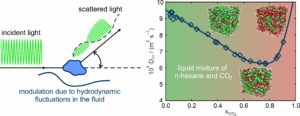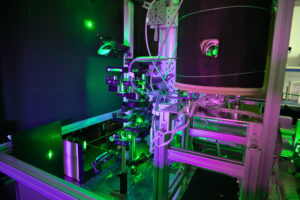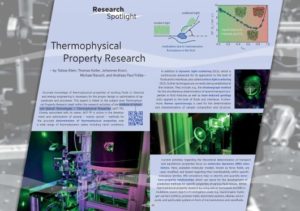Thermophysical Property Research
Accurate knowledge of thermophysical properties of working fluids in chemical and energy engineering is necessary for the proper design or optimization of apparatuses and processes. This aspect is linked to the subject area Thermophysical Property Research dealt within the research activities of the Institute of Advanced Optical Technologies – Thermophysical Properties (AOT-TP).
Closely associated with its name, AOT-TP is active in the development and optimization of several – mainly optical – methods for the accurate determination of thermophysical properties over a wide range of thermodynamic states including harsh conditions.
 In addition to dynamic light scattering (DLS), which is continuously advanced for its application to the bulk of fluids and to interfaces, also called surface light scattering (SLS), further techniques are currently being established at the institute. They include, e.g., the shadowgraph method for the simultaneous determination of several transport properties in fluid mixtures as well as laser-induced gratings (LIG) applied to the bulk of fluids and interfaces. Furthermore, Raman spectroscopy is used for the determination and characterization of sample composition and structure.
In addition to dynamic light scattering (DLS), which is continuously advanced for its application to the bulk of fluids and to interfaces, also called surface light scattering (SLS), further techniques are currently being established at the institute. They include, e.g., the shadowgraph method for the simultaneous determination of several transport properties in fluid mixtures as well as laser-induced gratings (LIG) applied to the bulk of fluids and interfaces. Furthermore, Raman spectroscopy is used for the determination and characterization of sample composition and structure.
 Current activities regarding the theoretical determination of transport and equilibrium properties focus on molecular dynamics (MD) simulations. Here, available molecular models, known as force fields, are used, modified, and tested regarding their transferability within specific substance families. MD simulations help to identify and quantify structure-property relationships which can serve for the development of prediction methods for specific properties of various fluid classes. Within thermophysical property research by using optical techniques and MD simulations, recent objects of investigation cover, e.g., liquid organic hydrogen carriers (LOHCs), polymer melts, electrolyte systems, alkanes, ionic liquids, and particulate systems in form of microemulsions and nanofluids.
Current activities regarding the theoretical determination of transport and equilibrium properties focus on molecular dynamics (MD) simulations. Here, available molecular models, known as force fields, are used, modified, and tested regarding their transferability within specific substance families. MD simulations help to identify and quantify structure-property relationships which can serve for the development of prediction methods for specific properties of various fluid classes. Within thermophysical property research by using optical techniques and MD simulations, recent objects of investigation cover, e.g., liquid organic hydrogen carriers (LOHCs), polymer melts, electrolyte systems, alkanes, ionic liquids, and particulate systems in form of microemulsions and nanofluids.
by Tobias Klein, Thomas Koller, Johannes Knorr, Michael Rausch, and Andreas Paul Fröba

